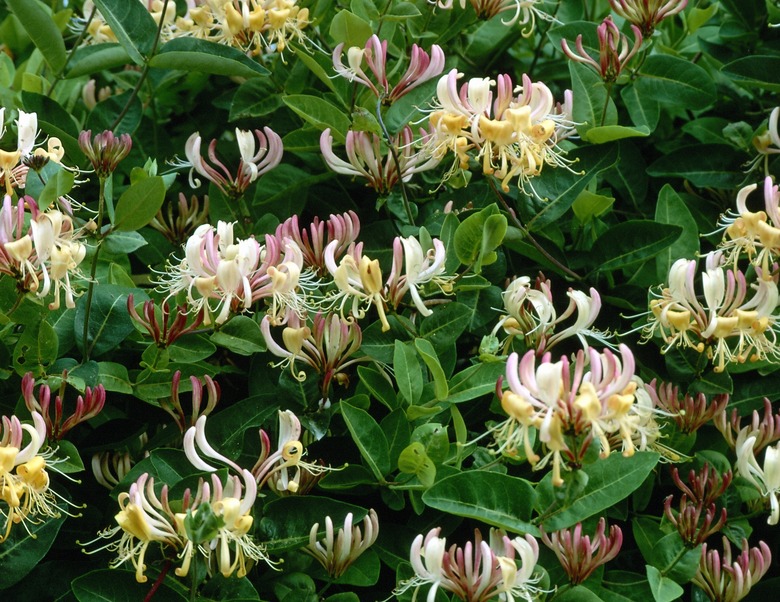Invasive Vs. Native Honeysuckle
Honeysuckle (Lonicera spp.) likely gets its common name from a time-honored right of childhood: plucking the flowers from the vine and sucking out the sweet nectar. In fact, these fast-growing, flowering vines are an excellent choice if you have children: They are easy to grow and nontoxic. Choose carefully, however, as some honeysuckle species — Lonicera japonica in particular — are invasive.
Invasive Vs. Native
Step 1
Honeysuckles can be loosely divided into two groups: those that are native to North America, and those that are not. Both groups contain plants that spread or naturalize, but the latter group contains most of the invasive species. Invasive plants are defined as those that have escaped cultivation and are overwhelming more desirable, native species. Most non-native, invasive honeysuckles are native to Asia and were brought over to the United States by settlers hoping to use the plants for landscaping purposes. Native honeysuckles are very similar — if not identical — to their non-native cousins, which can make it difficult to identify whether or not your honeysuckle is native, non-native or invasive. Many commercial retailers no longer sell invasive honeysuckle species and cultivars, so you are usually safe if you get your plant from a retail center rather than a friendly neighbor.
- Honeysuckle (Lonicera spp.)
- Many commercial retailers no longer sell invasive honeysuckle species and cultivars, so you are usually safe if you get your plant from a retail center rather than a friendly neighbor.
Non-Native Species
Step 1
Japanese honeysuckle (Lonicera japonica) is perhaps the most invasive honeysuckle species. As its name implies, is not native to North America. Hardy in U.S. Department of Agriculture plant hardiness zones 4 through 9, Japanese honeysuckle features pale, yellow-and-white flowers and dark, bluish-black berries. Amur honeysuckle (Lonicera maackii) is another non-native honeysuckle that has invasive tendencies, according to the University of Connecticut Plant Database. Unlike Japanese honeysuckle, however, this plant grows as a shrub or small tree, which means it doesn't have the creeping habit that makes Japanese honeysuckle so hard to get rid of. Still, Amur honeysuckle can escape cultivation. The plant, which features creamy white flowers, is extremely tolerant of cold conditions and is hardy in USDA zones 2 through 8.
- Japanese honeysuckle (Lonicera japonica) is perhaps the most invasive honeysuckle species.
- Amur honeysuckle (Lonicera maackii) is another non-native honeysuckle that has invasive tendencies, according to the University of Connecticut Plant Database.
Native Species
Step 1
Most native honeysuckles are native to the eastern part of the United States, but today they are found throughout the country. The trumpet honeysuckle (Lonicera sempervirens) is native to the east coast of the United States. Hardy in USDA zones 4 through 9, it is prized for its scarlet, trumpet-shaped blooms. This vine honeysuckle has several cultivars and is quick to cover arbors and fences. Although it will naturalize, it is not considered an invasive species, according to the Missouri Botanical Garden. Like the trumpet honeysuckle, Lonicera flava is not considered invasive. This species, which is so common that it is often simply called "honeysuckle," features the bright yellow flowers that are often a hallmark of the genus. Hardy in USDA zones 5 through 8, it is a twining vine and will not become invasive.
- Most native honeysuckles are native to the eastern part of the United States, but today they are found throughout the country.
- Hardy in USDA zones 5 through 8, it is a twining vine and will not become invasive.
Cultivation
Step 1
Honeysuckles grow in full sun or partial shade, and in average soil. They are hardy, vigorous plants and don't require a lot of care to thrive. In fact, they are even resistant to deer and to the chemical that black walnut trees emit, so go ahead and plant one next to your black walnut tree. They do prefer well-draining locations, so don't plant honeysuckle in wet soil or in a depression. The brighter the flowers, the more likely they are to attract hummingbirds, bees and butterflies.
References
- Missouri Botanical Garden: Lonicera Flava
- Virginia Tech Department of Forest Resources and Environmental Conservation: Lonicera Japonica Fact Sheet
- Virginia Tech Department of Forest Resources and Environmental Conservation: Lonicera Maackii Fact Sheet
- Missouri Botanical Garden: Lonicera Sempervirens
